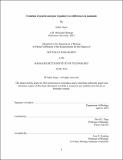| dc.contributor.advisor | David C. Page. | en_US |
| dc.contributor.author | Naqvi, Sahin. | en_US |
| dc.contributor.other | Massachusetts Institute of Technology. Department of Biology. | en_US |
| dc.date.accessioned | 2019-10-11T20:32:48Z | |
| dc.date.available | 2019-10-11T20:32:48Z | |
| dc.date.issued | 2019 | en_US |
| dc.description | This electronic version was submitted by the student author. The certified thesis is available in the Institute Archives and Special Collections. | en_US |
| dc.description | Thesis: Ph. D., Massachusetts Institute of Technology, Department of Biology, 2019 | en_US |
| dc.description | Cataloged from student-submitted PDF version of thesis. "June 2019." | en_US |
| dc.description | Includes bibliographical references. | en_US |
| dc.description.abstract | Sex differences are widespread in mammalian health, development, and disease. Ultimately, sex differences derive from the sex chromosomes; males are XY and females are XX, but the mammalian X and Y chromosomes evolved from an ancestral pair of ordinary autosomes. These genetic sex differences, through a variety of regulatory mechanisms, give rise to sex differences in gene expression across the genome, which in turn result in the observed phenotypic differences between males and females. In this thesis, I take an evolutionary perspective on this pathway, using computational analysis of both publically available and newly generated data to provide insight into the molecular basis of mammalian sex differences. | en_US |
| dc.description.abstract | First, to better understand the selective forces underlying the evolution of the amniote sex chromosomes from ordinary autosomes, we reconstructed gene-by-gene dosage sensitivities on the ancestral autosomes through phylogenetic analysis of microRNA target sites, finding that preexisting heterogeneities in dosage sensitivity shaped the evolution of both the mammalian XY and avian ZW sex chromosomes. Second, to understand the extent to which genome-wide sex differences are conserved across both tissues and species, we conducted a five-species, twelve tissue survey of sex differences in gene expression, finding that most sex bias in gene expression has arisen during since the last common ancestor of boroeutherian mammals, and that evolutionary gains or losses of regulation by sex-biased transcription factors likely drove a significant fraction of lineage-specific changes in sex bias. | en_US |
| dc.description.abstract | Third, we used the results of this survey to show that conserved sex bias in gene expression contributes to the male bias in height and body size observed in a range of mammalian species, including humans. Together, these studies suggest that dosage sensitivity played a key role in both the evolution of mammalian sex chromosomes and their contribution to phenotypic sex differences, as well revealing the widespread nature and phenotypic impact of sex differences in gene expression across the genome. | en_US |
| dc.description.statementofresponsibility | by Sahin Naqvi. | en_US |
| dc.format.extent | 215 pages | en_US |
| dc.language.iso | eng | en_US |
| dc.publisher | Massachusetts Institute of Technology | en_US |
| dc.rights | MIT theses are protected by copyright. They may be viewed, downloaded, or printed from this source but further reproduction or distribution in any format is prohibited without written permission. | en_US |
| dc.rights.uri | http://dspace.mit.edu/handle/1721.1/7582 | en_US |
| dc.subject | Biology. | en_US |
| dc.title | Evolution of genetic and gene regulatory sex differences in mammals | en_US |
| dc.type | Thesis | en_US |
| dc.description.degree | Ph. D. | en_US |
| dc.contributor.department | Massachusetts Institute of Technology. Department of Biology | en_US |
| dc.identifier.oclc | 1121476771 | en_US |
| dc.description.collection | Ph.D. Massachusetts Institute of Technology, Department of Biology | en_US |
| dspace.imported | 2019-10-11T21:37:11Z | en_US |
